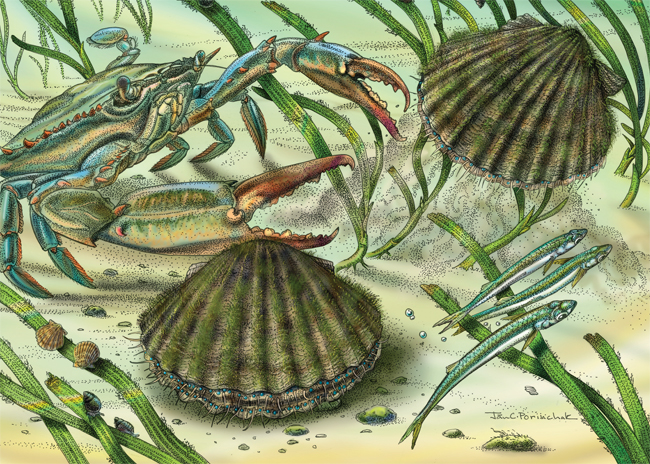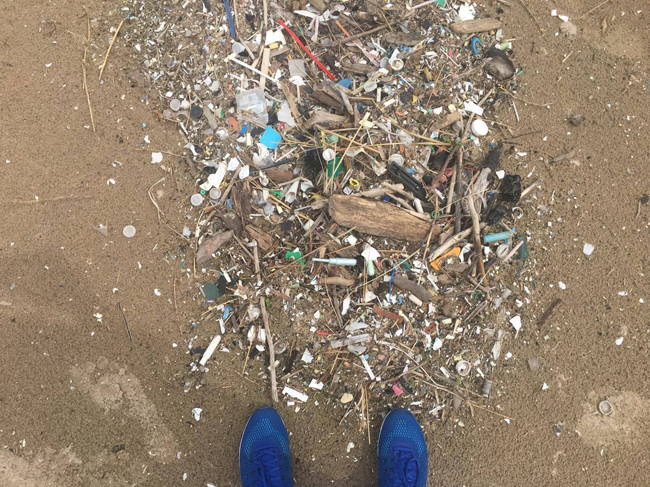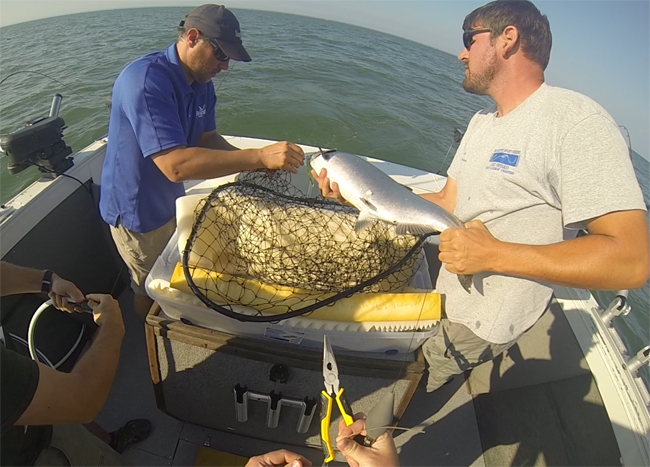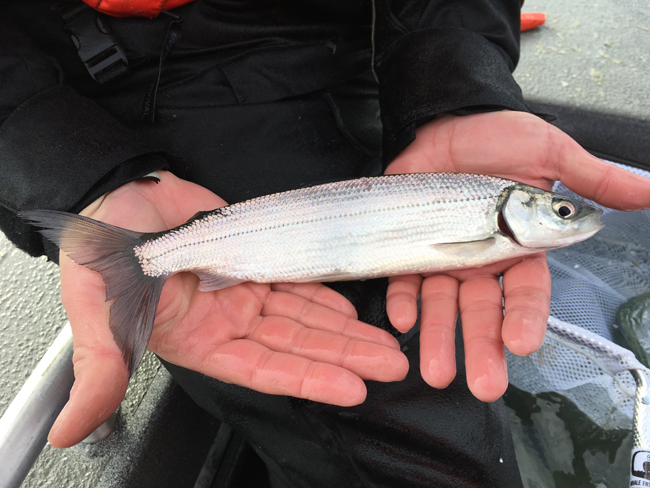Contact:
Lane Smith, Research Program Coordinator, NYSG, E: lane.smith@stonybrook.edu, P: (631) 632-9780
Stony Brook, NY, March 2, 2020 - For nearly 50 years, New York Sea Grant (NYSG) has been supporting university-based research related to a variety of marine, Hudson estuary, and Great Lakes topics and issues.
Here are some summaries for recently-completed investigations, which address topics such as the impacts of plastic pollution to our coastlines and waters as well as climate change and ocean acidification on aquatic organisms. Also, researchers examined migration and behavioral patterns of Great Lakes species including king salmon and cisco as well as how dams in the Hudson-Mohawk Watershed might alter fisheries restoration plans of, among others, river herring and eels.

Waters around eastern Long Island supported a large bay scallop fishery and Peconic Bay scallops are legendary. Recent NYSG funded research examined the potential impacts of climate change on these and other shellfish populations. Credit: Jan Porinchak
Impacts Of Climate Change And Ocean Acidification On Economically Important Shellfish In New York: Are There Effective Mitigation And Adaptation Measures? (R/FBM-38, Dr. Chris Gobler)
In New York State, shellfish fisheries are economically important and are threatened by climate change. Some regions of NY's coast are already experiencing levels of pH, dissolved oxygen, and temperature that are stressful to marine life, including shellfish.
Investigators of this study conducted field and laboratory experiments to determine the impacts of temperature, dissolved oxygen, and acidification on shellfish.
Field results showed large daily and geographic variation of the measured variables and their potential impacts on shellfish, with some areas maximally impacted and others minimally. Laboratory results showed that coastal acidification and hypoxia (low oxygen conditions in our waters) that occur chronically or on diurnal time scales can significantly impair the normal development, growth, respiration, and survival among early life stage bivalves. Furthermore, the study showed that acidification and hypoxia together have a greater negative impact than either do separately. The findings from this project have practical implications for resource managers and shellfish hatchery operators.

Plastic pollution on our shorelines is plain to see. But concern is mounting over the impacts of microplastics in our waters. Recent NYSG research examined the potential impacts microplastics can have on the aquatic food chain in Lake Ontario. Credit: Paul C. Focazio/NYSG
Determining Degradation Rates, Products and Impacts for Prominent Plastics in Freshwater Environs (R/CTP-53, Dr. Sherri Mason; Dr. Joseph Gardella, Jr.; Dr. Courtney Wigdahl-Perry)
Microplastics are well-established pollutants within the Great Lakes, but less is known about their environmental impacts. Studies have shown that contaminants from the water adhere to microplastic particles, which are small enough to be ingested by plankton and other filter feeders. Once ingested, these plastics can serve as a source of organic contaminants to other organisms up the food chain. Investigators conducted chemical analysis of microplastics obtained from water samples and carried out laboratory feeding studies to determine growth and survival rates of a model organism with microplastics in their feed.
The results of the project demonstrated the ability of microplastic particles to attract pollutants. Further, laboratory results illustrate that filter-feeding cladocerans will consume microplastics that are the size of natural prey items, indicating that microplastics are likely to have an important impact on zooplankton in freshwater environments.

NYSG Fisheries Specialist Jesse Lepak (at left) prepares to attach a satellite tag to a Lake Ontario king salmon on a charter boat run by Rochester Sport Fishing. This was part of research to assess the movement and behavior of this important fishery. Credit: Cornell University
Vertical Habitat Of Salmonids In Lake Ontario Using Archival Tags And Hydrodynamic Models (R/FBF-24, Dr. Lars G. Rudstam; Dr. James M. Watkins)
King salmon supports one of the most important fisheries of Lake Ontario. Characterizing their movement and behavior is valuable information for fishery biologists to manage fisheries, and for anglers to find and catch king salmon more efficiently.
This study investigated king salmon activity in Lake Ontario using pop-off satellite archival tags (PSATs). The tags record depth, temperature, light conditions, and acceleration every second to reconstruct individual movement and behavior. The data from the tags has provided detailed movement data that has elucidated how salmon use the habitat. The fine-scale temperature data collected from the tags improved bioenergetics models of salmonids used for evaluating future responses to stressors such as climate change and prey availability.

Restoring free-flowing rivers and unrestricted access to a watershed, like the Hudson River (where hundreds of dams and culverts act as barriers), is critical for restoring migration of native populations of American eel, blueback herring and alewife. Recent NYSG research is providing local communities with tools to help with decision making when considering dam removal. Credit: Ethan Nedeau
Reconnecting Waters For Eels And River Herring: A Mediated Modeling Approach To Assess Receptivity To Dam Removal In The Hudson-Mohawk Watershed (R/FHD-14, Dr. Karin Limburg; Dr. Andrea Feldpausch-Parker)
The Hudson River Watershed (HRW) contains at least 797 registered dams on its tributaries that disrupt connectivity for endemic diadromous fishes to access critical upstream nursery and spawning habitat. Derelict dams are often targeted for removal to aid river connectivity efforts. However, communities interested in dam removal must consider multiple social and biophysical challenges before making a decision.
This study used a series of engagement strategies in the fields of environmental communication and systems thinking to determine how stakeholders in the HRW perceive dam removal, and what drives receptivity to removal given other priorities, interests, and managing institutions.
Results found that dam removal community discourse was multifaceted and involved competing restoration priorities among key actors. Furthermore, engagement activities identified a general lack of awareness regarding the potential benefits of restored eel or herring populations to local communities. This study highlights the utility of multiple engagement modes to foster a greater understanding and communication of dam removal complexities.

Restoring cisco populations in Lake Ontario is the focus of an international (U.S./Canadian) collaborative effort. Recent NYSG research has provided critical information on cisco population genetics and current and potential breeding locations. Credit: Ellen George
Identifying Genetic and Habitat Limitations to Cisco Restoration in Lake Ontario (R/XG-23, Dr. Matt Hare; Dr. Lars Rudstam)
The cisco was once a commercially and ecologically important fish in Lake Ontario. However, cisco populations began declining in the late 1800’s and early 1900’s due to overfishing, habitat degradation, and impacts from invasive species.
Currently, cisco populations are very low but interest in restoring the species in Lake Ontario is growing, as it is an important part of the native food web. More information is needed to understand the status of cisco in Lake Ontario, such as the distribution and number of spawning populations, the structure and connectedness between these populations, and their level of genetic diversity.
The aim of this study was to address several of these major knowledge gaps facing cisco restoration in Lake Ontario. The research team mapped potential spawning sites using historical data and habitat features. The team then placed egg mats to determine if spawning is still occurring in these areas. Genetic diversity was also assessed from fin tissue of cisco collected from several locations. The study found high genetic diversity across spawning populations and confirmed cisco spawning in two previously unknown locations.
More Info: New York Sea Grant
New York Sea Grant (NYSG), a cooperative program of Cornell University
and the State University of New York (SUNY), is one of 34 university-based
programs under the National Oceanic and Atmospheric Administration’s
National Sea Grant College Program.
Since 1971, NYSG has represented a statewide network of integrated
research, education and extension services promoting coastal community
economic vitality, environmental sustainability and citizen awareness
and understanding about the State’s marine and Great Lakes resources.
Through NYSG’s efforts, the combined talents of university scientists
and extension specialists help develop and transfer science-based
information to many coastal user groups—businesses and industries,
federal, state and local government decision-makers and agency managers,
educators, the media and the interested public.
The program maintains Great Lakes offices at Cornell University, SUNY
Buffalo, SUNY Oswego and the Wayne County Cooperative Extension office
in Newark. In the State's marine waters, NYSG has offices at Stony Brook
University in Long Island, Brooklyn College and Cornell Cooperative
Extension in NYC and Kingston in the Hudson Valley.
For updates on Sea Grant activities: www.nyseagrant.org has RSS, Facebook, Twitter, and YouTube links. NYSG offers a free e-list sign up via www.nyseagrant.org/nycoastlines for its flagship publication, NY Coastlines/Currents, which is published quarterly. Our program also produces an occasional e-newsletter,"NOAA Sea Grant's Social Media Review," via its blog, www.nyseagrant.org/blog.